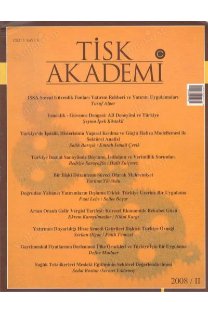Analitik Hiyerarşi Süreci (AHS) Yöntemi ile Taş Kömürü Madenciliği Alanlarının Değerlendirilmesi
Analitik Hiyerarşi Süreci (AHS) Yöntemi ile Taş Kömürü Madenciliği Alanlarının Değerlendirilmesi Enerjiye duyulan ihtiyaç kömür sektöründeki yatırımların temel nedenini oluşturmaktadır. Enerji tüketiminin artması ve kömürün enerji üretimindeki payının artacağı tahminleri ülkeleri kömür madenciliği konusunda daha dikkatli davranmalarını sağlamaktadır. Buna bağlı olarak kömür sektöründeki yatırımların yapılması için uygun olan üretim alanlarının objektif olarak belirlenmesi önemli bir faktörü oluşturmaktadır. Bu çalışmada, bir kişinin veya belirli bir grubun önceliklerini nicel ve nitel olarak dikkate alınmasını sağlayan bir yaklaşım olan Analitik Hiyerarşi Süreci kullanılarak, Zonguldak'ta bulunan taş kömürü madenciliği alanlarının değerlendirilmesi amaçlanmıştır. Çalışmada karara etki eden kriterler belirlenmiş ve analiz işlemleri gerçekleştirilmiştir. Çalışma sonucunda kömür madenciliği alanlarının seçimi konusunda bir öneri sunulmuştur.
The Assessment of Hard Co al Mining Areas by Using Analytic Hierarchy Process (AHP) Method
The need of energy is the main cause for the investment in coal sector. Increase in energy consumption and estimates about the share of coal increase in energy production make the countries act more carefully about coal mining. In this context, determining proper production areas objectively in order to make investments in coal sector is a substantial factor. The purpose of this study is to assess the hard coal mining areas in Zonguldak by using the Analytic Hierarchy Process, which is an approach of providing taking cognizance of priorities of one person or group as an qualitative or quantitive. In this study, the criteria which have an impact on decision making are determined and the analyses are carried out. As a result of the study, a suggestion is offered for determining coal mining areas.
___
- BP (2012). Statistical Review of World Energy.
- 15.04.2013 tarihinde http://www.bp.com/ statisticalreview adresinden erişildi.
- Bhushan, N. ve Rai, K. (2004). Strategic Decision Making: Applying the Analytic Hierarchy Process. London: Springer
- Bowen, B. H., Irwin, M. W., Parke, W., Atkinson, M. ve Noland, N. (2008). Coal Mine Site Selection & Indiana's Economic Growth.
- 06.01.2014 tarihinde http://www.purdue. edu/dp/energy/CCTR/ adresinden erişildi.
- Güngör, İ. ve İşler, D. B. (2005). Analitik Hiyerarşi Yaklaşımı İle Otomobil Seçimi. ZKÜ Sosyal Bilimler Dergisi. 1 (2), 21-33
- Herath, G. ve Prato, T. (2006). Using Multi-Criteria Decision Analysis in Natural Resource Management. Burlington: Ashgate Publishing Company
- Hummel, J. M., Omta, S. W. F., Rossum, W. V., Verkerke, G. J. ve Rakhorst, G. (1998). The Analytic Hierarchy Process: An Effective Tool for a Strategic Decision of a Multidisciplinary Research Center. Knowledge, Technology, and Policy. 11 (1-2), 41-3
- IEA (2012). Key World Energy Statistics. 01.05.2013 tarihinde http://www.iea.org/ publications/freepublications/publication/ kwes.pdf adresinden erişildi.
- IEA (2013). Coal Information 2013. Paris: International Energy Agency Publication. Ishizaka, A. ve Labib, A. (2009). Analytic Hierarchy Process and Expert Choice: Benefi ts and Limitations. ORInsight. 22 (4), 201-220
- Kuruüzüm, A. ve Atsan, N. (2001). Analitik Hiyerarşi Yöntemi ve İşletmecilik Alanındaki Uygulamaları. Akdeniz İ.İ.B.F. Dergisi. 1 (1). 83-105
- Mustafa, M. A., ve Al-Bahar, J. F. (1991). Project Risk Analytic Assessment Using the Hierarchy Process. IEEE Transactions on Engineering Management. 38 (1). 46-52
- Özden, Ü. H. (2008). Analitik Hiyerarşi Yöntemi ile İlkokul Seçimi. Marmara Üniversitesi İİBF Dergisi. XXIV (1), 299-320
- Partovi, F. ve Hopton, W. (1994). The Analytic Hierarchy Process as Applied to Two Types of Inventory Problems. Production and Inventory Management Journal. 35. 13-19
- Ramanathan, R. (2001). A Note on The Use of The Analytic Hierarchy Process for Environmental Impact Assessment. Journal of Environmental Management. 63. 27-35
- Saaty, T. L. (1986). Axiomatic Foundation of the Analytic Hierarchy Process. Management Science. 32 (7). 841-855
- Schmoldt, D. L., Kangas, J. ve Mendoza, G. A. (2001). Basic Principles of Decision Making in Natural Resources and the Environment. The Analytic Hierarchy Process in Natural Resource and Environmental Decision Making. Dordrecht: Kluwer Academic Publishers
- Scholl, A., Manthey, L., Helm, R. ve Steiner, M. (2005). Solving Multiattribute Design Problems With Analytic Hierarchy Process and Conjoint Analysis: An Empirical Comparison. European Journal of Operational Research. 164 (3), 760-777
- Singh, R. D. (2004). Principles and Practices of Modern Coal Mining. New Delhi: New Age International (P) Limited, Publishers
- TKİ (2012). Kömür Sektör Raporu (Linyit). 20.04.2013 tarihinde http://www.enerji.gov. tr/yayinlar_raporlar/Sektor_Raporu_TKI_ 2011.pdf adresinden erişildi.
- TTK (2013). İstatistik Raporları. 05.04.2013 tarihinde http://www.taskomuru.gov.tr adresinden erişildi.
- Ustasüleyman, T. (2009). Bankacılık Sektö- ründe Hizmet Kalitesinin Değerlendirilmesi: Ahs-Topsis Yöntemi. Bankacılar Dergisi. 69. 33-43
- Vaidya, O. S. ve Kumar, S. (2006). Analytic Hierarchy Process: An Overview of Applications. European Journal of Operational Research. 169. 1-29
- Yaralıoğlu, K. (2001). Performans Değerlendirmede Analitik Hiyerarşi Proses. Dokuz Eylül Üniversitesi İİBF Dergisi. 16 (1). 129-142
- Zahedi, F. (1986). The Analytic Hierarchy Process: A Survey of the Method and Its Applications. Interfaces. 16 (4). 96-108
- ISSN: 1306-6757
- Yayın Aralığı: Yılda 2 Sayı
- Başlangıç: 2006
- Yayıncı: Türkiye Isveren Sendikalari Konfederasyonu
Sayıdaki Diğer Makaleler
Analitik Hiyerarşi Süreci (AHS) Yöntemi ile Taş Kömürü Madenciliği Alanlarının Değerlendirilmesi
Türkiye'de Emek Piyasasının Çevrimsel Hareketinin Cinsiyet Bazında Analizi
Yusuf Soner BAŞKAYA, Gönül ŞENGÜL
Yasal Greve Müdahalede Grev Oylaması Uygulaması
Vergi Yapısında ve Vergi Sistemlerinde Uluslararası Eğilimler Üzerine Bir Değerlendirme
Transfer Fiyatlandırma Etik Midir?
LEVENT YAHYA ESER, NAGİHAN BİRİNCİ
Teknolojik Gelişme ve Ekonomik Büyüme: OECD Ülkeleri Üzerine Bir Uygulama
Hüseyin TATLIDİL, İsmet DEMİRAĞ
Türkiye'de Bölgesel Eko-Verimliliğin Ölçülmesi: Veri Zarflama Analizi ile Bir Değerlendirme
Algılanan Hizmet Kalitesi Ölçüm Modelleri İle İlgili Yazın Taraması
